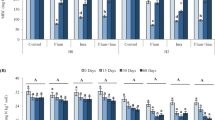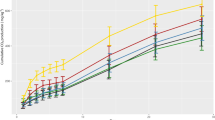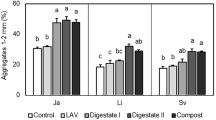Abstract
HERBICIDES exert selective effects on soil microorganisms as well as on higher plants, a fact which is implied by reports that certain soil organisms, and in particular bacteria, adapt themselves and are able to decompose chemicals, such as 2,4-dichlorophenoxyacetic acid1, methylchloro-phenoxyacetic acid2, dalapon3, amitrole4, paraquat5 and simazine6. These direct changes following treatment with herbicides were thought to be only temporary because the activity of the adapted flora declines as the substrate is broken down. But there can also be long term ecological consequences of prolonged use of a particular herbicide. Agricultural enterprises such as intensive cereal production may involve continued use of the same chemical year after year and, consequently, there may be gradual, but cumulative, qualitative changes in the soil microflora.
This is a preview of subscription content, access via your institution
Access options
Subscribe to this journal
Receive 51 print issues and online access
$199.00 per year
only $3.90 per issue
Buy this article
- Purchase on Springer Link
- Instant access to full article PDF
Prices may be subject to local taxes which are calculated during checkout
Similar content being viewed by others
References
Audus, L. J., Nature, 166, 356 (1950).
Steenson, T. I., and Walker, N., J. Gen. Microbiol., 18, 692 (1958).
Magee, L. A., and Colmer, A. R., Canad. J. Microbiol., 5, 255 (1959).
Chandra, P., Weed Res., 4, 54 (1964).
Baldwin, B. C., Biochem. J., 101, 15P (1966).
Kaufman, D. D., J. Agric. Food Chem., 13, 238 (1965).
Calderbank, A., J. Sci. Food Agric., 19, 246 (1968).
Smith, J. E., and Fletcher, W. W., Hort. Res., 4, 60 (1964).
Shennan, J. L., and Fletcher, W. W., Weed Res., 5, 266 (1965).
Wilkinson, V., thesis, Univ. Oxford (1967).
Wilkinson, V., and Lucas, R. L., New Phytol., 68, 709 (1969).
Wilkinson, V., and Lucas, R. L., New Phytol., 68, 701 (1969).
Author information
Authors and Affiliations
Rights and permissions
About this article
Cite this article
WILKINSON, V. Ecological Effects of Diquat. Nature 224, 618–619 (1969). https://doi.org/10.1038/224618a0
Received:
Revised:
Issue Date:
DOI: https://doi.org/10.1038/224618a0
This article is cited by
-
Influence of foliar application of pesticides on leaf extracts and phylloplane microflora of corn
Folia Microbiologica (1982)
Comments
By submitting a comment you agree to abide by our Terms and Community Guidelines. If you find something abusive or that does not comply with our terms or guidelines please flag it as inappropriate.



